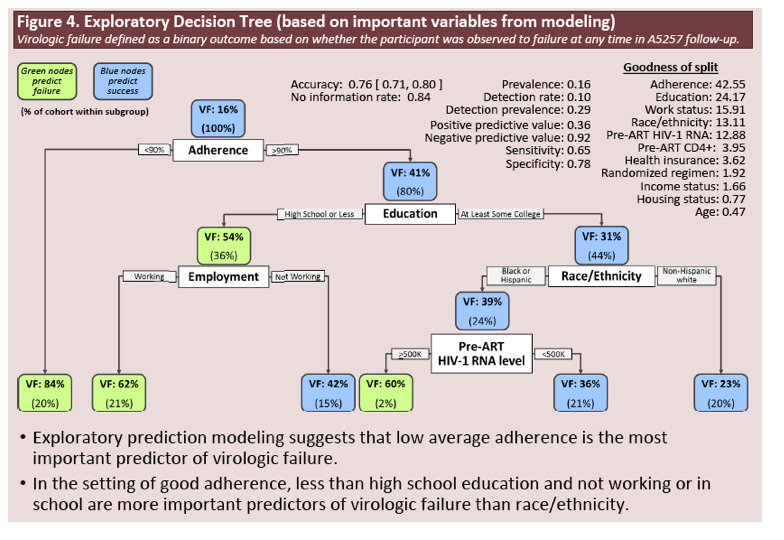 |
 |
 |
| |
Gender and Racial Disparities in Initial Antiretroviral
Treatment Outcome: ACTG A5257
|
| |
| |
Reported by Jules Levin
CROI 2016 Feb 22-24 Boston
Heather J. Ribaudo1; Raphael J. Landovitz2; Lumine H. Na3; Jeffrey L. Lennox4; Ighovwerha Ofotokun4; Susan E. Cohn5; Daniel Kuritzkes6; Judith S. Currier2; for the ACTG A5257 Study Team
1Harvard Sch of PH, Boston, MA, USA;2David Geffen Sch of Med at Univ of California Los Angeles, Los Angeles, CA, USA;3Univ of Edinburgh, Edinburgh, UK;4Emory Univ Sch of Med, Atlanta, GA, USA;5Northwestern Univ, Chicago, IL, USA;6Harvard Med Sch, Boston, MA, USA
Other factors associated with higher VF risk included non-adherence, younger age, high pre-ART viral load, low income, less education, IV drug history, and not working or in school.

Women and ethnic/racial minority groups in the US remain at greater risk of VF of initial ART with modern ART regimens. For women and Hispanics, this excess risk appears explained by race/ethnicity and socio-demographics, respectively. In contrast, an excess risk of VF for blacks remains after adjustment for non-adherence and socio-demographics. This work helps define populations at high VF risk who may benefit from early targeted interventions.
Program abstract
Inferior virologic outcomes of initial antiretroviral treatment (ART) for women and ethnic/racial minority groups have been reported. We examined this finding in a US-based setting with modern ART regimens and determined whether socio-demographics or non-adherence explain these differences.
ACTG A5257 randomized 1809 participants to ART with emtricitabine/tenofovir disoproxil fumarate plus atazanavir/ritonavir (/r), raltegravir, or darunavir/r. Study follow-up ended in 2013. This planned secondary analysis included 1762 participants categorized as non-Hispanic white, non-Hispanic black, and Hispanic based on self report. Cox proportional hazards models examined the association of sex and race/ethnicity on the hazard of virologic failure (VF) adjusting for demographic and baseline factors including age, HIV-1 disease status and socio-demographic variables; adherence by self-report was included as a time-updated covariate. Analyses were intent to treat.
The study sample was 34% white, 43% black, and 22% Hispanic. Median age was 37 years; 24% were women. Probability of VF by 96 weeks [95%CI] was 11% [10, 13] in men and 16% [12, 19] in women. VF probability was 7% [5, 9] in whites, 17% [14, 20] in blacks and 13% [10, 17] in Hispanics.
Differential effects of sex or race/ethnicity by treatment arm were not apparent (P>0.40).
A greater VF risk for women compared to men was apparent in unadjusted analysis (P=0.005) but not after adjustment for race/ethnicity (P=0.29).
Compared to whites, blacks and Hispanics had a greater hazard of VF (unadjusted HR=2.8 [2.0, 3.8] and 2.0 [1.4, 2.8], respectively). While adjustment for socio-demographic factors appeared to account for the excess VF risk for Hispanics (1.2 [0.7, 1.8]), an excess risk remained for blacks after adjustment for socio-demographics and adherence (1.7 [1.1, 2.5]). Other factors associated with higher VF risk included non-adherence, younger age, high pre-ART viral load, low income, less education, IV drug history, and not working or in school (Figure).
Women and ethnic/racial minority groups in the US remain at greater risk of VF of initial ART with modern ART regimens. For women and Hispanics, this excess risk appears explained by race/ethnicity and socio-demographics, respectively. In contrast, an excess risk of VF for blacks remains after adjustment for non-adherence and socio-demographics. This work helps define populations at high VF risk who may benefit from early targeted interventions.







|
| |
|
 |
 |
|
|